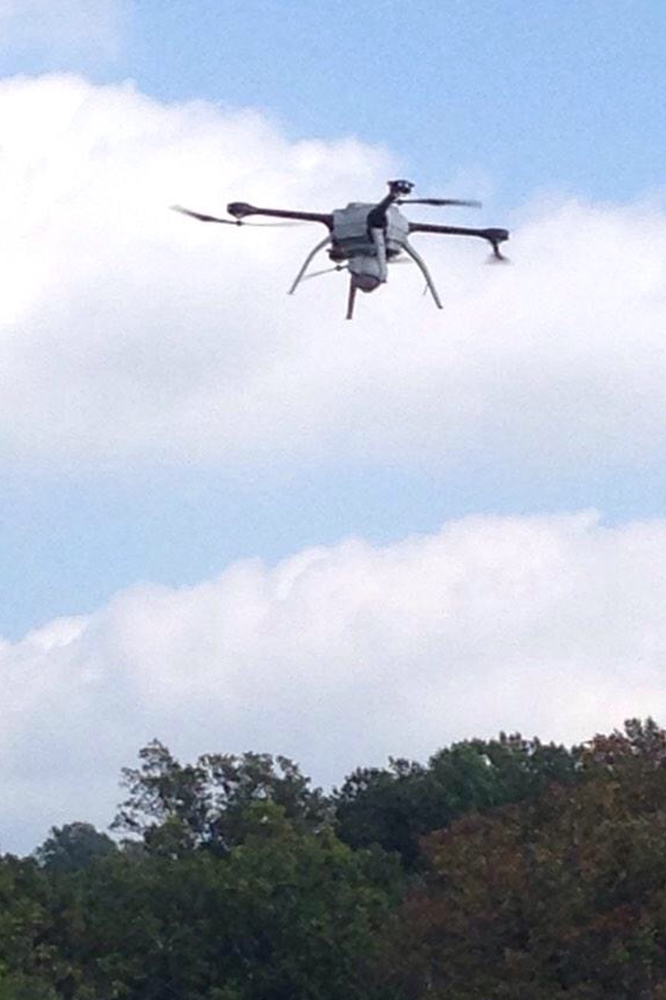Emergency responders focus on unmanned aircraft for search, public safety at state workshop

As searchers intensified their efforts to find a missing University of Virginia student in late September, engineers with the Mid-Atlantic Aviation Partnership worked with law enforcement officials to use an unmanned aerial vehicle in a search mission — perhaps the first such use of the technology in Virginia’s history.
Now, first responders and emergency managers will learn more about the use of unmanned aerial vehicles, also known as drones, at a meeting today at Virginia Tech’s Southern Piedmont Agricultural Research and Extension Center in Blackstone, Virginia.
The event will feature a discussion of unmanned aircraft applications, the process to receive authorization to fly, and training and certifications needed to fly.
“We want our emergency responders to have the training and knowhow to use unmanned aircraft when the situation calls for a quick response,” said Virginia Gov. Terry McAuliffe. “Virginia has been an early supporter of this technology and we want to have it at our fingertips in a search-and-rescue situation.”
Qualified operators need to receive special authorization from the Federal Aviation Administration to fly unmanned aircraft. Six test programs across the nation, including one at Virginia Tech, are working with the Federal Aviation Administration to make it easier to deploy unmanned aircraft in emergencies, such as the search for missing student Hannah Graham in October.
“The searchers had to contend with tricky geography and it’s tough to do on foot,” said Rose Mooney, executive director of the Mid-Atlantic Aviation Partnership. “With unmanned aircraft, we can get visual information over difficult terrain, and we are able to fly at lower altitudes, under 500 feet, in weather conditions that ground manned aircraft.”
Within hours of the request on Tuesday, Sept. 30, the Federal Aviation Administration issued an emergency Certificate of Authorization to the Mid-Atlantic Aviation Partnership to assist the Albemarle County Police Department in the search.
MAAP, headquartered at the Institute for Critical Technology and Applied Science at Virginia Tech in Blacksburg, Virginia, held an emergency safety review board meeting Tuesday night and on Wednesday morning sent a team to fly a quadcopter to view hard-to-access areas.
John Coggin, chief engineer of the Mid-Atlantic Aviation Partnership, with pilots J.P. Stewart from the Department of Mechanical Engineering and Chris Morrell from the Bradley Department of Electrical and Computer Engineering, used an Aeryon SkyRanger to help cover the search area for authorities.
The aircraft provides continuous “eyes-on-target” for situational awareness and it is useful for collecting aerial images and video in situations where manned aircraft, satellites, and ground-based photography are less effective, according to Aeryon Labs.
Today’s event is presented by the Virginia Department of Aviation, the Virginia Department of Emergency Management, the Virginia Economic Development Partnership, the Mid-Atlantic Aviation Partnership, and Virginia Tech.
“Much has been said about unmanned aircraft technology as an economic engine for the state and national economy,” Mooney said, “but search-and-rescue is an important purpose of this technology.”
Dedicated to its motto, Ut Prosim (That I May Serve), Virginia Tech takes a hands-on, engaging approach to education, preparing scholars to be leaders in their fields and communities. As the commonwealth’s most comprehensive university and its leading research institution, Virginia Tech offers 240 undergraduate and graduate degree programs to more than 31,000 students and manages a research portfolio of $513 million. The university fulfills its land-grant mission of transforming knowledge to practice through technological leadership and by fueling economic growth and job creation locally, regionally, and across Virginia.








